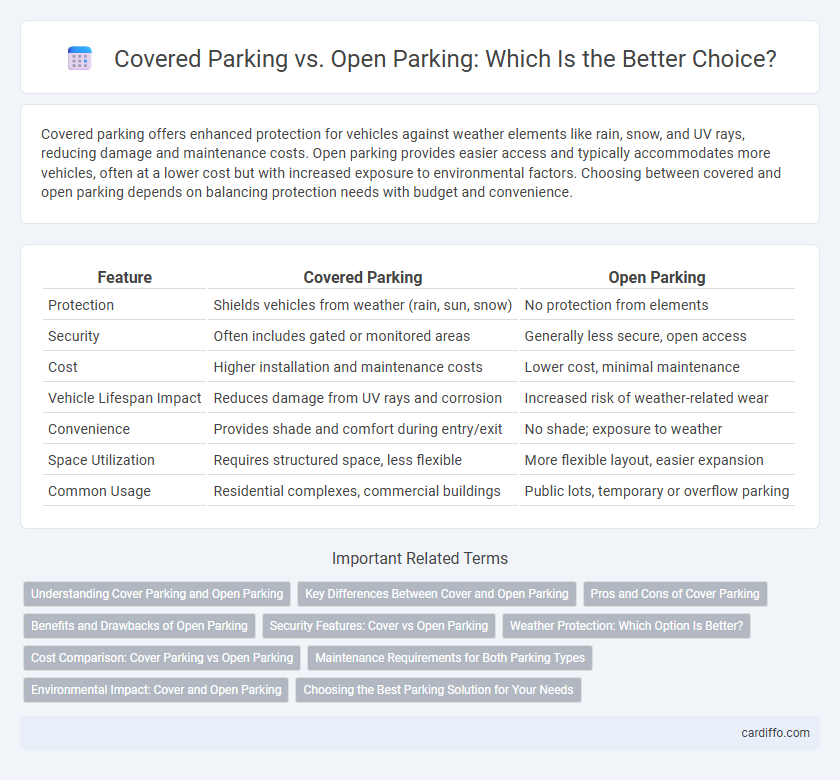Covered parking offers enhanced protection for vehicles against weather elements like rain, snow, and UV rays, reducing damage and maintenance costs. Open parking provides easier access and typically accommodates more vehicles, often at a lower cost but with increased exposure to environmental factors. Choosing between covered and open parking depends on balancing protection needs with budget and convenience.
Table of Comparison
| Feature | Covered Parking | Open Parking |
|---|---|---|
| Protection | Shields vehicles from weather (rain, sun, snow) | No protection from elements |
| Security | Often includes gated or monitored areas | Generally less secure, open access |
| Cost | Higher installation and maintenance costs | Lower cost, minimal maintenance |
| Vehicle Lifespan Impact | Reduces damage from UV rays and corrosion | Increased risk of weather-related wear |
| Convenience | Provides shade and comfort during entry/exit | No shade; exposure to weather |
| Space Utilization | Requires structured space, less flexible | More flexible layout, easier expansion |
| Common Usage | Residential complexes, commercial buildings | Public lots, temporary or overflow parking |
Understanding Cover Parking and Open Parking
Covered parking offers protection from weather elements such as rain, snow, and sun, reducing wear and tear on vehicles and enhancing security. Open parking provides easy access and typically lower costs, making it a popular choice for short-term or high-turnover usage. Choosing between covered and open parking depends on factors like climate, budget, and vehicle protection needs.
Key Differences Between Cover and Open Parking
Covered parking offers protection from weather elements such as rain, snow, and UV rays, reducing vehicle damage and maintaining its exterior condition. Open parking is more cost-effective and provides easier access but exposes vehicles to environmental factors and potential security risks. The decision between covered and open parking depends on factors like budget, climate, and vehicle usage frequency.
Pros and Cons of Cover Parking
Covered parking offers enhanced protection against weather elements such as rain, snow, and UV rays, reducing vehicle wear and tear and maintaining its exterior condition. It provides added security against theft and vandalism, often incorporating gated access or surveillance systems. However, covered parking typically involves higher costs for construction and maintenance, and may have limited availability compared to open parking spaces.
Benefits and Drawbacks of Open Parking
Open parking offers cost-effective and accessible vehicle storage with no structural constraints, making it ideal for high-turnover areas and large capacity needs. However, exposure to environmental elements such as rain, sun, and snow can lead to faster vehicle wear and lower security compared to covered parking. Its simplicity reduces construction and maintenance expenses but increases vulnerability to theft and weather-related damages.
Security Features: Cover vs Open Parking
Covered parking offers enhanced security features such as protection from theft, vandalism, and weather-related damage, utilizing gated access, surveillance cameras, and secure entry points. Open parking, while more accessible and visible, typically lacks physical barriers and surveillance systems, increasing vulnerability to unauthorized access and vehicle damage. Choosing covered parking significantly reduces risks through controlled environments and monitored security measures.
Weather Protection: Which Option Is Better?
Covered parking offers superior weather protection by shielding vehicles from rain, snow, hail, and harmful UV rays, significantly reducing exterior damage and interior fading. Open parking exposes cars to the elements, leading to faster paint deterioration, windshield damage, and uncomfortable interiors during extreme temperatures. Choosing covered parking extends vehicle longevity and maintains resale value by preserving its condition against environmental hazards.
Cost Comparison: Cover Parking vs Open Parking
Covered parking generally incurs higher costs due to expenses related to construction, maintenance, and security compared to open parking lots. Open parking offers a more economical solution with lower installation and upkeep costs but may result in increased vehicle exposure to weather elements, potentially leading to higher long-term maintenance expenses. Choosing between covered and open parking requires weighing initial investment against protection benefits and durability factors.
Maintenance Requirements for Both Parking Types
Covered parking requires regular inspection and maintenance of roofing materials, structural supports, and drainage systems to prevent leaks and corrosion. Open parking demands frequent surface upkeep, such as sealing asphalt, repainting lines, and managing debris accumulation. Both types benefit from routine cleaning and snow or ice removal to ensure safety and preserve functionality.
Environmental Impact: Cover and Open Parking
Covered parking reduces environmental impact by protecting vehicles from weather elements, which decreases emissions from additional maintenance and prolongs vehicle lifespan. Open parking contributes to heat island effects due to exposed asphalt surfaces absorbing solar radiation, increasing surrounding temperatures and energy consumption. Incorporating permeable materials or vegetation in open parking areas can help mitigate runoff and enhance local air quality, balancing environmental concerns between both parking types.
Choosing the Best Parking Solution for Your Needs
Covered parking offers enhanced vehicle protection from weather elements such as rain, snow, and sun, reducing potential damage and maintenance costs. Open parking provides a cost-effective and flexible solution for areas with high vehicle turnover or limited space constraints. Evaluating factors like climate, budget, security, and convenience helps determine the ideal parking solution tailored to specific needs.
Cover parking vs open parking Infographic

 cardiffo.com
cardiffo.com